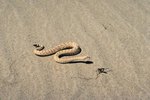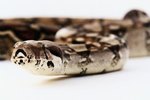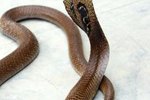
Six snakes are native to Iraq, with its desert climate and mountainous terrain. All are poisonous, according to Dean Alessandrini, a former Kentucky Reptile Zoo keeper. During the Iraq War, military personnel were advised to be extremely cautious because of these snakes. One species, the saw-scaled viper, is blamed for more deaths annually than any other snake in the world, Alessandrini says. The other snakes are the desert cobra, the field's sand viper, the lebetine viper, the desert horned viper and the Kurdistan viper.
Desert Cobra
The desert cobra is found throughout Iraq, but it's least likely to be seen in the north. These snakes, with their shiny black, polished exterior, can grow up to 4 feet long, although their average size is about 2 feet. Desert cobras are quick, and they're known for their keen sense of smell but weak eyesight. They're not picky eaters. They will eat anything from birds to other snakes. Unlike some of its Iraq colleagues, this snake is not easily agitated, but it will strike if provoked.
Saw-Scaled Viper
This snake, the smallest of Iraq's vipers, is known for the arrow mark on top of its head. It measures a maximum of 20 inches long and its color depends on its environment, although it's typically brown or tan. The saw-scaled viper is found in rocky and sandy terrains throughout the southern deserts of Iraq. It's also found in India, Sri Lanka, Iran, Israel and Saudi Arabia. This snake is considered highly venomous and bad-tempered; it's quick to strike if it feels threatened. It's blamed for more deaths worldwide than any other snake.
Levantine Viper
The lebetine viper, an endangered species, is also known as the blunt-nose viper, the Levantine viper, the Levant viper and the mountain addler. It's known by its blunt nose and can grow to 6 feet long. Unlike some snakes, its colors vary from brown, red, yellow or pink, making it sometimes difficult to identify. Although it's slow and lethargic, it has been known to strike aggressively when provoked. Its diet consists of mammals, reptiles and birds, which it kills with a large dose of venom that quickly causes pain, swelling and tissue damage.
The Desert Horned Viper
The desert horned viper, is an endangered species. It's known for its devilish looks: horns above each eye. It grows to no more than 2 feet long. This snake can burrow into the sand in seconds, mainly to get away from the desert heat. This snake scrapes its scales together, making a sound that resembles that of a rattlesnake. Feasting mostly on lizards and small rodents, the desert horned viper packs a hard punch. Its venom can do major damage to tissue.
The Kurdistan and Field's Sand Vipers
The Kurdistan viper likes to hang out in the rocky slopes in the higher elevations of northeast Iraq. The zigzag pattern on its back comes in gray or grayish brown with a row or orange or yellow spots. It averages 2 to 3 feet long. It's rare for a human to encounter this snake in the wild. The Field's Sand Viper, although venomous, is slow moving. During the day it usually hides under shrubs during in the western portion of Iraq. Averaging about 2 feet long, the snake can be beige, yellowish brown, gray or bluish gray with a black tail tip. The Field's Sand Viper has a single horn above each eye. It's uncommon to hear of bites to humans, but this snake's venom can cause hemotoxic and neurotoxic effects.
References
- ReptileChannel.com: Venomous Snakes in Iraq
- Tisch Family Zoological Gardens in Jerusalem: Black Python (Desert Cobra)
- PawsForWildlife: Levantine Viper (Macrovipera Lebetina)
- Who Zoo: Desert Horned Viper
- News Blaze: Snake Bites and Scorpion Stings
- Navy and Marine Corps Public Health Center: Venomous Snakes in Iraq and Kuwait
Photo Credits
-
George Doyle/Stockbyte/Getty Images
Writer Bio
Crystal Owens is the managing editor at a Northern Virginia newspaper with more than 10 years experience in journalism. She has worked as a reporter in Florida, Pennsylvania, South Carolina and Georgia, covering various topics from crime to politics to health care. She studied communications at the University of North Florida.




